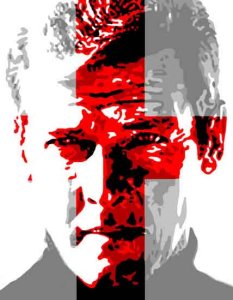|
How
The
Saint Saved Bond

When
Sean
Connery declined an invitation to return after Diamonds Are Forever,
Eon knew they were in very dangerous waters again. The first
non-Connery Bond, George Lazenby, was not overwhemingly accepted purely
because
he wasn't Sean Connery. The second non-Connery Bond was supposed to be
American actor John Gavin; but Connery's suprise return ended Gavin's
tenure before it even began. Relief for Eon who knew Gavin was another
huge gamble.
The
next Bond
would make his
debut in 1973's Live
And Let Die, and either carry it through the
seventies - or go down as the man who sunk the franchise.
Broccoli
considered young British actor Michael Billington. Billington would
become a perennial contender up until For Your Eyes Only
in 1981.
Darkly handsome in a Lazenby-esque way, the young UFO star promised a
meaner take on the character. Meanwhile the studio were thinking about
Hollywood stars: Eastwood; Mcqueen; Burt Reynolds. All ludicrous:
except director Guy Hamilton returned from a trip to America and
announced that Reynolds was his man. Perfect. The problem was Cubby who
didn't like the idea of an American Bond. The Studio said: well, if you
don't want Reynolds, find us a viable British Bond who has name
recognition.
With
no obvious
British Bond
on the horizon, Cubby resurrected a name that had cropped up more than
once in their Bond casting discussions all the way back to 1962. The
name was Roger Moore. Moore was suggested by Fleming to be the first
Bond, and was contacted again to discuss replacing Connery in the late
sixties. On both occasions, Moore's commitments to television precluded
him from advanced negotiation. Moore was nearly 45 now and his chance
seemed to have gone; but Cubby wasn't so sure. Roger was now finally
available and free from television entanglements.
On
the
plus side
Moore was
6'2, still handsome and well known from the television series The
Saint. He was adept at heroic roles with a penchant for light humour.
He could conceivably be a compromise choice and carry Bond into the
seventies. On the minus side he was almost 45 and would be seen by
purists as lightweight and a departure from the Connery/Lazenby model.
Saltzman wasn't keen; but when Cubby advised Roger to cut his hair and
lose weight he began to relent. Roger's excellent performance in
the The
Man who
Haunted Himself was another plus. A Hollywood
star as Bond was unpalatable; and young Billington would carry the
major
risk of a repeat of the Lazenby affair. Pragmatism triumphed. Roger
Moore would be the third James Bond.
Roger's
first
two Bond films
failed to strike gold at the box-office. They were both so-so entries
in the Bond canon. They were dubious in tone and featured topical
elements that
would date them quickly. Roger was fine without being great. Ok without
being terrible. If anything the series was sliding into an abyss of
apathy. Far from saving the series, it looked like Roger would be the
man at the helm when the ship ran aground. After The Man with The
Golden Gun stalled at the box-office and met with bland
reviews, it
seemed like James Bond was almost finished. When Saltzman sold out his
share in the franchise and left Broccoli as the sole producer the
writing was on the wall. But a curious thing happened that would lay
the ground for the future of Bond. Cubby took this as a personal
challenge. He resolved to make the biggest Bond ever and restore 007 to
his former glory.
The
Spy Who Loved Me,
a ludicrously fantastical and lavishly produced epic, finally cemented
Roger as Bond and revived the franchise. Not only was the seventies
assured but the eighties now looked certain to see James Bond too. At
the age of 49 Moore had done the impossible: a non-Connery Bond had
proved popular and viable. Cubby too had proved he could go it
alone. Roger would go on to make one or two films too many and never be
a favourite with purists, but he did all that was asked of him.
Including
probably saving a franchise.
-
Robert Fossil
c 2006
Alternative 007
|

|



